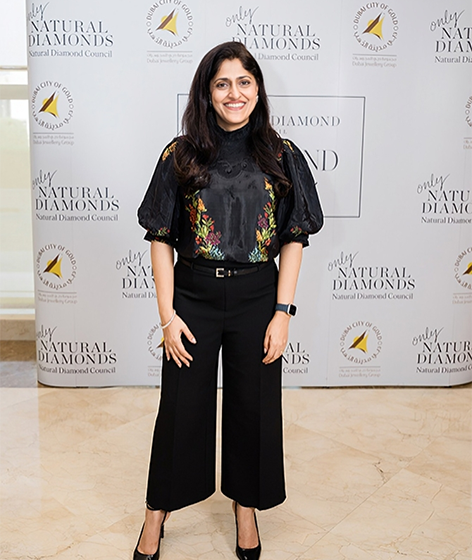JUMEIRAH INTRODUCES THE MALTESE FALCON, A JUMEIRAH PRIVÉ EXPERIENCE
Diamond Dialogues.. A Conversation with Richa Singh, Managing Director – India & Middle East, Natural Diamond Council (NDC)

In an exclusive interview, Richa Singh, Managing Director for India and the Middle East at the Natural Diamond Council (NDC), speaks about the evolving dynamics of the diamond industry, consumer behavior, and Dubai’s growing role as a global diamond destination.
Introducing the Natural Diamond Council
Richa Singh:
I head the Natural Diamond Council for India and the Middle East. The NDC is a not-for-profit organization that works closely with industry stakeholders from retailers and designers to trade bodies and manufacturers with a mission to grow the natural diamond industry responsibly.
Our goal is to empower consumers with knowledge and confidence, helping them appreciate the enduring beauty, authenticity, and value of natural diamonds.
The Diamond Dialogue Initiative
Q: You recently hosted the first “Diamond Dialogue” session in Dubai. What was the idea behind this initiative?
Richa Singh:
“Diamond Dialogue” is an open platform designed to bring together every segment of the diamond supply chain from miners to retailers to discuss key challenges and opportunities for the industry.
Dubai, often celebrated as the City of Gold, has immense potential to also emerge as a global diamond hub. That’s why we partnered with the Dubai Jewellery Group to launch this initiative. Our aim is to foster collaboration and create actionable outcomes to strengthen the diamond ecosystem in the region.
We were privileged to have Mr. Ahmad Ali Moosa, Director, Fair Trade & Business Protection in Dubai Corporation for Consumer Protection and Fair Trade (DCCPFT), who shared valuable insights on how Dubai can evolve as a trusted international center for diamonds. Together, we’re also developing marketing and terminology guidelines to ensure that both natural and lab-grown diamonds are represented transparently and responsibly allowing both categories to grow in a healthy, parallel manner.
Challenges Facing the Natural Diamond Industry
Q: What do you see as the main challenges currently facing the natural diamond sector?
Richa Singh:
The biggest challenge today is the shift in consumer behavior.
Traditionally, the local jeweler was a trusted family advisor the first person you’d consult for weddings or major celebrations. Today’s consumer, however, is highly informed and digitally connected. They have access to vast global knowledge and multiple opinions online.
Our industry needs to match that pace. Retail teams must be well-trained and factually equipped to engage with such consumers confidently. When consumers make informed choices, the entire category benefits.
The second challenge is Dubai’s uniquely global consumer base. The city attracts shoppers from India, Russia, Africa, Europe, and the U.S., all with different expectations. Retail professionals must be able to communicate effectively with this multicultural, well-traveled audience.
Ultimately, knowledge and education are key. The faster the industry shares consistent, accurate information, the stronger consumer trust will become.
The Impact of Gold Prices
Q: How have rising gold prices affected the diamond jewelry market?
Richa Singh:
Gold price fluctuations have actually brought both challenges and opportunities. While higher gold prices have made pure gold jewelry more expensive, they have also encouraged many first-time buyers especially from smaller towns and emerging markets to explore studded jewelry, including real diamonds.
This shift is introducing new consumers to the world of diamonds, which is very positive. The focus now must be on maintaining quality, craftsmanship, and design relevance to ensure long-term growth.
On Lab-Grown Diamonds
Q: How do lab-grown diamonds fit into the larger diamond narrative?
Richa Singh:
Lab-grown diamonds were first created in the 1950s for industrial use, and about 25 years ago they entered the jewelry market as a technological innovation. But as production scaled up, prices fell dramatically today, a 3-carat lab-grown diamond can retail online for under $200.
Both natural and lab-grown diamonds have a place in the market, but they serve different purposes. Natural diamonds are billions of years old, rare, and emotionally significant they hold generational value. Lab-grown diamonds are accessible, affordable, and ideal for fashion-forward, everyday jewelry.
Both can coexist as long as there’s transparency and clear consumer communication.
Distinguishing Between Natural and Lab-Grown Diamonds
Q: How can consumers be sure of what they’re buying?
Richa Singh:
With today’s technology, every diamond can be identified accurately within seconds using advanced detection machines. All reputable retailers use certified testing equipment so that customers can instantly verify authenticity.
Earlier, only loose stones were certified, but now even finished jewelry can be tested and certified. Institutions like the GIA have updated their grading systems to clearly differentiate between natural and lab-grown diamonds.
Transparency builds trust and that’s crucial for both segments.
On Value and Buyback Policies
Q: There’s often a perception that diamonds don’t hold resale value. What’s your view?
Richa Singh:
Many leading retailers, such as Malabar Gold & Diamonds now offer 100% buyback on their own natural diamond jewelry, which has greatly improved consumer confidence.
However, I believe natural diamonds shouldn’t be seen purely as a financial investment, like gold or real estate. They carry emotional, aesthetic, and generational value pieces that mark milestones and memories.
As I often say, “No one smiles when looking at a mutual fund statement, but everyone smiles when they look at a piece of jewelry that holds memories.”
Natural diamonds are not just products; they are symbols of emotion and legacy.
Cultural Shifts and Evolving Tastes
Q: How are cultural shifts influencing jewelry preferences in India and the Middle East?
Richa Singh:
Traditionally, jewelry in these regions meant pure gold. But exposure to global trends from Paris and Milan to New York has broadened consumer tastes. Today’s buyers want jewelry that blends heritage with modernity.
This evolving aesthetic is paving the way for real diamond jewelry to become more mainstream and versatile across the region.
Looking Ahead: The Future of Diamonds
Q: What does the future hold for the diamond industry?
Richa Singh:
The future is bright. As consumers become more expressive and value-driven, authenticity, sustainability, and storytelling will define the next phase of the diamond industry.
Natural Diamonds will continue to symbolize love, achievement, and legacy emotions that transcend generations.
A Final Thought
Richa Singh:
“Every piece of diamond jewelry has a story. You remember when and why you bought it to celebrate joy, to heal, to reward yourself, or to mark a milestone. That emotional connection is what makes a diamond truly timeless.”







